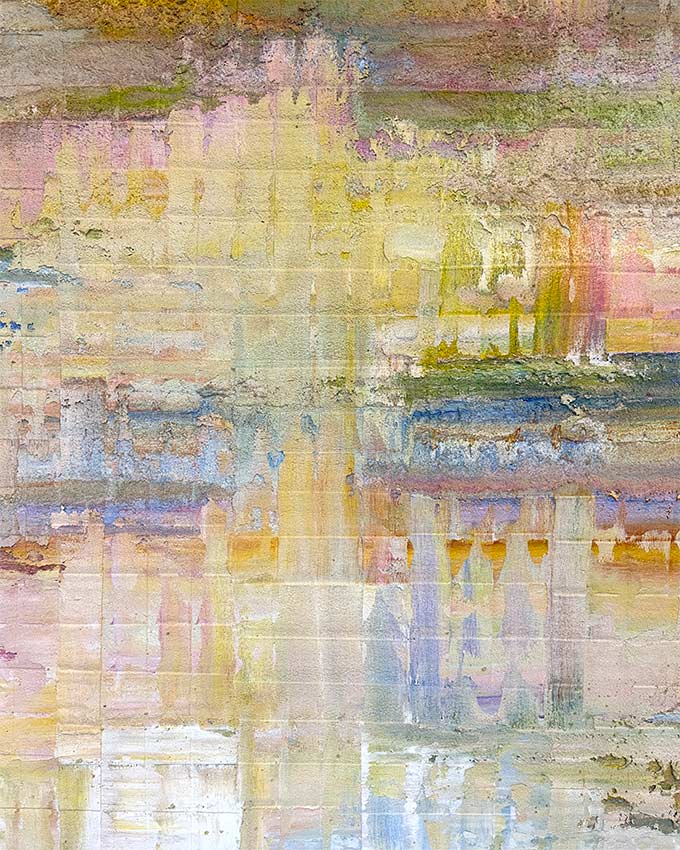Artist Sassan Behnam-Bakhtiar‘s signature style of painting is a unique one. In a method he calls peinture raclée, he lays down vivid coats of pigment, then scrapes it away to reveal layers of colour and texture on the canvas. Associating his art style with the idea of “hiding”, he describes his process as an impromptu experience where the art reveals itself as he puts it down on the canvas.
In March this year, Behnam-Bakhtiar unveiled his solo show at the PhillipsX gallery in London. Titled The Age of Energy, it explored the restorative power of trees and nature—taking inspiration chiefly from his experience growing up French-Iranian in Iran, as well as the periods of trauma and healing in his life. In the exhibition, Behnam-Bakhtiar revealed a series of paintings he had been working on since 2019. “When I first came up with the idea for these paintings, I was on the journey of finding enlightenment by making the darkness conscious,” he says. The series, which the artist created while living in the South of France, was highly influenced by his environment. In particular, Behnam-Bakhtiar shares that his surroundings brought forth clarity of vision.

As for what’s next, a new solo exhibition titled Ocean is set to debut in Monaco in June. Supported by the Fondation Prince Albert II de Monaco, part of the proceeds from Behnam-Bakhtiar’s work will go to missions advocating for ocean health. Here, the artist lets us in on his process, his contemplation on energy and where his practice will go from here.
Your peinture raclée method has to do with laying down paint and scraping it away. How did you come to learn or develop this technique?
It took three years of experimenting in my atelier, behind closed doors. I was aiming to visually show what I feel and see. To me, this style of work offers a portal to an evolved human existence—what one would see through a third eye.
The paintings in The Age of Energy are said to address themes of healing from trauma. Can you tell us more about that?
I never thought I would recover from all the torture I had endured as a child, when I was abandoned after the revolution in Iran. I was looking for only two things—safety and love. What eventually saved me was my inner self, once I learnt how to control and manifest my energy.

What does the energy of nature mean to you?
Life within nature is deeper than we know, and it mirrors the life we hold within us as human beings. Trees can naturally conduct important processes necessary for life—like clockwork. They can even absorb negative energy and transform it into positive energy. Imagine what we would be able to achieve if we truly put our minds to it.
The paintings in the series seem to depict the texture of trees. What inspired this choice of motif?
Think about the peace and calm you feel when you lie under a tree or walk through a forest. Trees can affect our mental and emotional states—they have an energy frequency and an aura, just like human beings and all living things. With roots reaching deep into the earth, they have strong grounding energy. Their vibrations are slower than us, deeper and more concentrated. Essentially, they emanate safety, security and stability, qualities that many of us crave.
Each work aims to reveal beyond what we can see with our eyes, and is a direct reminder of how energy can totally transform our existence. We need to manifest our dormant energies and push beyond boundaries set by our societies, ground ourselves and provide safety and security for ourselves and our loved ones, as these trees do.

Tell us about your next solo show in Monaco, titled Ocean.
I feel a great pull towards our birthplace, the almighty ocean. I want to do my part in helping ocean preservation efforts globally, and I’m excited to be collaborating with the Fondation Prince Albert II de Monaco in the Principality of Monaco, to showcase a new series of works. Half of the proceeds from the exhibition will be allocated to the foundation, to support their important mission in protecting and progressing ocean health for the present and future generations.





